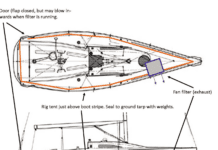Cutting Rope Can Be Tough
Being retired comfortably enough to indulge in some enjoyable and expensive foolishness, weve bought a big old yawl in magnificent structural condition. There are a couple of problems being corrected by professionals. But basically, all thats needed is the old spit and polish.
I love wood, so Im doing all the varnishing and painting…and the interior is my domain, of course.
This beautiful old boat has enough rigging to keep my husband happy for a year or so. Hes a rope nut. Loves splicing. He considered doing it all in manila, but he says that splicing and handling manila is very hard on the hands. So, hes making no attempt to be traditional with the rigging. Hes combed the catalogs for weeks, made selections and bought a considerable variety of very modern line made of every high-tech fiber known to man. Hes in his element.
However, I am tired of hearing him swear morning, noon and night about how hard some of these lines are to splice and even to cut.
For instance, how do you cut some of these lines with the fancy cores made of fibers stronger than steel? Id like to be able to say to him, Hey, Bill, why don’t you try…
Mary Herrington
San Francisco, California
Hes right about manila. Being not only scratchy, its also a natural, cellular, absorbent fiber that strips the hands of oil and induces dryness and cracking of the skin.
However, as we have pointed out in several reviews of modern line, rope, cordage or cable (whatever you prefer to call it), splicing Dacron, nylon and any of the other synthetics is often very difficult. (Our most recent tests of nylon anchor rode were in the April 15, 1998 issue. The December 1997 Double Issue contained the data on 33 varieties of line used for halyards, sheets, etc.)
The fact is that synthetic lines are slippery (requiring extra tucks in a splice), frizz easily (requiring careful taping or whipping) and, depending on their construction, sometimes can be very difficult to work without a fid. Eye splices in braid sometimes require leather gloves in the milking step. And splicing used braid usually is futile (even wetting it doesn’t help much).
As for cutting nylon and Dacron, cut is a misnomer. Dont saw back and forth with a knife. The edge will go hopelessly dull in a hurry. Instead, apply a ring of tape, place the line on a narrow wood block, position the knife blade on the rope and simply rock back and forth. What youre doing is crushing the individual fibers, without doing much damage to the knife. An alternative, if you like gadgets, is the HotBlade, a small butane-powered version of the 110V Hot Knife made by New England Ropes. The HotBlade, on which we reported in our Chandlery column in the July 1, 1998 issue, is in the catalogs and stores. Still another alternative weve used is a new tool from Sears. Called a Handi-Cut, it has a sharp blade and plastic anvil (both replaceable). We broke one trying to cut Kevlar-corded line. The blade skewed sideways and broke the blade housing, which was plastic. Sears replaced the guaranteed-forever Craftsman tool, no questions asked.
Cutting the more exotic braided lines poses problems. The very advanced core fibers called Kevlar, Technora, Vectran, Certran, etc. are, as advertised, stronger (by weight) than steel. They don’t melt at any temperature you can muster up with a Hot Knife, HotBlade or Zippo lighter. Further, they resist a knife blade with a vengeance.
Rigger Meredith Russo, who works in the rigging shop of The Ships Store in Portsmouth, Rhode Island, said that she uses a cheap, very sharp knife to saw away at the synthetics. She said its hard work.
Dont use a good knife, she said. Youll ruin it.
She said she gets but one or two cuts from the knife, then must stop to sharpen it.
Finishing the end of a braided line with an exotic core can be done with good whipping. But Russo had another suggestion:
Slide the cover back a bit and cut the core about a half inch short, she said. Then, slide the cover back down and use heat to seal and round off the cover, capturing the core within. Makes a nice end.
Hope this helps, Mary Herrington.
Sail Area/Displacement Ratio
I keep reading about the SA/D ratio. How is it calculated and how does one interpret the numbers?
Adrian Peters
Lac La Biche, Alberta
Divide displacement by 64, take the cube root of this value, then square it and divide the result into sail area. The number will range from about 12 to 30. Most cruiser/racers will have a SA/D between about 15 and 17. The high-performance sport boats will be in the 20s. Its a good gauge of how much sail power a boat has.



































